Related Article: Editor’s Note – Assembling Our Stories
By Diane Seo ’85
For nearly a year, we’ve been living in what seems like a perilous alternate universe, a world continuing to be deterred by a raging virus that has changed everyday life, possibly permanently. COVID-19 has affected all of us in varied ways. Everyone has a story.
Our Punahou community has its own rich mix of stories, which undoubtedly mirrors the larger world. Woven into these tales are day-to-day struggles, serendipitous occurrences, dashed spirits, frustrations, new ideas and directions and thoughtful reflections.
We have dedicated this issue of the Bulletin to relay stories of life in the pandemic from our students, faculty, staff, parents and alumni. These pieces were crafted primarily from interviews on Webex. Despite the virtual platform, the conversations were intimate – just people chatting about life. The formal veil that sometimes exists between reporter and subject was not present.
What was discovered during the process of reporting these stories was that everyone struggles, but when people reflect inwardly and spot silver linings amid chaos, they can endure challenges. Many of the people interviewed for this package are doing just that, which made what might otherwise seem like ordinary lives, inspiring and remarkable.
We hope you enjoy these thoughtful, first-person accounts, enhanced by the beautiful art created by Academy and middle school artists. Collectively, they serve as a written and visual history of our School during an extraordinary era marked by disruptions and fear, but also hope and change.

Junior Ye Won Ham ’22 is co-chair of this year’s Carnival.
I came to Punahou in the sixth grade, but even before that, I always went to Punahou Carnival. I loved everything about it, and it was mind-boggling to me that the Junior Class ran the entire thing. I ran for vice president of the Junior Class, because the winner of that election would be one of the Carnival co-chairs. I didn’t get it, so I applied to be the other co-chair. I didn’t have high expectations, because my dean told me that it would be difficult for me to manage my heavy course load and be a co-chair. That’s why it was so surprising and exciting when I got an email saying I was picked. My dream came true, but then obviously the pandemic changed everything.
At first, I was disappointed that we wouldn’t be able to do a lot of the things that people get hyped up for at Carnival. We can’t all be together and have these same experiences. But as we started planning, we still bonded as a team. So yeah, it’s not what I expected, but it’s better than what I thought it was going to be.
My hope is that we will still have that feeling of Carnival – that excitement, that feeling of togetherness, because we’re still bringing people together, and it’s for a good cause. It’s not going to be as big as it usually is, but I hope people still get that feeling of Carnival. No matter how disappointed we are, no matter how different it may be, it’s important to take what you have and go with it.
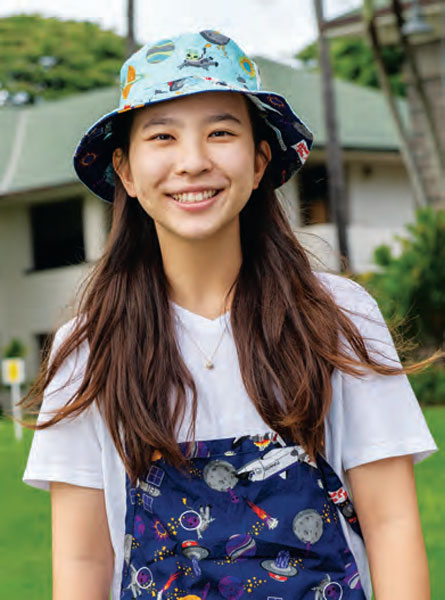

Jennifer Latham was ordained into the priesthood last July, after receiving her Master of Divinity. In September, she became a resident chaplain with Pacific Health Ministry, serving a local hospital. During the pandemic, she also began volunteering with Help Is On The Way, a local organization that provides free deliveries for ku¯puna and others in need. She and her husband, President Mike Latham ’86, have two daughters, Anya ’23 and Maile, now a freshman at Macalaster College in Minnesota.
Last March, my oldest daughter, who was finishing high school in Iowa, came here after her school went online. We got time with her that we wouldn’t have had, so there was this weird mix of celebration that she could be with us, and all the fear associated with the pandemic. But like other seniors, she was grieving the things she was losing – spring plays, prom and graduation. I had planned on going back to spend the last month of school with her, so I could go to the final band concerts and all of the things she was doing. But that didn’t happen, so we both grieved that loss. I tried to be a compassionate listener and help her reframe things, saying, “OK, this happened to us. There’s nothing we can really do about it, so how are we going to think about this so that we’re not paralyzed by it.”
Before the pandemic, we all thought some things were certain. What we’ve learned is that there’s very little certainty in the world. As a spiritual caregiver, people often come to you when things fall apart with their health, families or relationships. A spiritual caregiver is called upon to help people make sense of all that, so I often say about my own life – I’m very certain of my uncertainty. Approaching the pandemic that way was helpful. It allowed me to listen to Mike when he had concerns, when he needed to talk through something, and to reassure him that the pandemic is something nobody could have anticipated. Part of it was saying, “Well, this is not the first year you expected. Nobody expected this for your first year. But we’re grateful that you’re here, and you have this opportunity to help lead others and offer hope through this.” Crisis is also an opportunity for change. And I think in education, we’re discovering different learning styles for different kids, and finding that online learning works really well for some. Maybe there’s some way of using the knowledge we’re gaining to make education stronger in the future.
This is my first year of hospital chaplaincy, and it’s a completely new experience for me. During my four years in seminary, we were given skills to lead a congregation, like at a church. Now, I’m having to shift to think of the hospital, staff and patients as the congregation. I’m going in and meeting people, when they may not have chosen to have me come, or they may be facing a crisis. As a chaplain, I’m just seeing how people are doing and caring for them spiritually. I talk to them without any expectations or agenda.
I started volunteering with Help Is On The Way as a dispatcher. My kids also got involved in their food distributions, and that got them out of thinking, “Oh poor me,” to feeling like they were doing something helpful. I think during times of crisis, you can pivot and say, “This is what I can do within my own power that not only helps myself, but helps other people.”
We also started going for regular hikes as a family. Hiking always gives me a better perspective, and I always feel much happier when I walk out of the woods than when I started. There’s this place on Tantalus, at the top of the cliff. There’s a rock wall with ferns growing on the side. I call it the magical place, because every time I go there, the sun is shining through the trees and leaves, and the ferns are so delicate. It feels like a place where magic happens. My experience with the spirit is really wrapped up in nature. It’s where I find a lot of peace and grounding. Often, when I’m questioning things, I look for metaphors in nature, like not being afraid of what’s coming, and going with each moment as it comes. That’s what nature does. There’s also a cycle of life and death, and the different pieces of the ecosystem play a part – the roots, leaves, water and soil. All of these pieces of the system work together. To me, this is the metaphor of community. Those of us who can, should help others to support the system and sustain a healthy community.
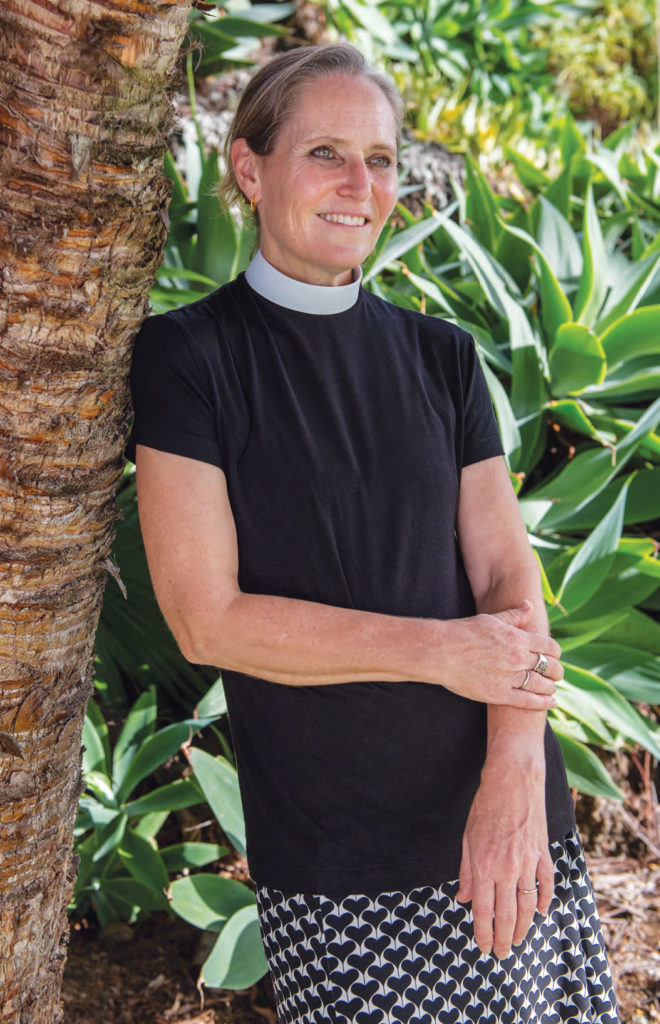

Richard Matsui ’03 is CEO and founder of San Francisco-based kWh Analytics, which specializes in risk management for solar energy investments. He is now working with various groups to enable others to come to Hawai‘i to work remotely or find new opportunities in the Islands.
There’s something that tells a fish you have to get back to home waters. It happens when your first kid shows up. Our firstborn was born on Jan. 7, 2020. In March, in California, the virus really hit. All day cares, everything closed down. We drove to a suburb and walked around with our little baby in the stroller. We were talking about what kind of life we wanted. My wife was the one who suggested coming to Hawai‘i. She said, “Your parents are there, maybe we could get help.” I really resisted it. We’d been in California for 10 years. We had all of our life plans centered around California. Career was the number one thing I think about. I started this company, and I do feel it’s my job to push and make it as successful as I can. My wife said, “Look, we don’t have child care in San Francisco. We can be a lot more effective at our work if we go back to Hawai‘i for a little bit.” By the time we were done with our walk, I was convinced. I think we decided on a Wednesday, and we flew out on Saturday.
I agreed to come here for one month. We were here two days – literally, two days – and we were thinking why on earth would we go back to San Francisco? One month became two months; two months became three. Now, we’ve been out here for many months. The funny thing is my wife now has a job in Hawai‘i. So 2020 went from not thinking about Hawai‘i at all to being permanent residents here.
You see a crisis like this, it really reframes the way you view life. We can have it all, both our family lives and work lives, if we can get our heads outside of our box. All the practical things that tied us to San Francisco suddenly became less important.
Yes, I wake up early. But especially in Hawai‘i, waking up at 4 a.m. – there’s no possible way you can complain about that. It’s beautiful. The food is great, and I get to see my parents enjoying my baby. Wow, grandparents and grandchildren are really made for each other. It sounds so obvious, but as a relatively new parent, it was a discovery. And my baby loves it here.

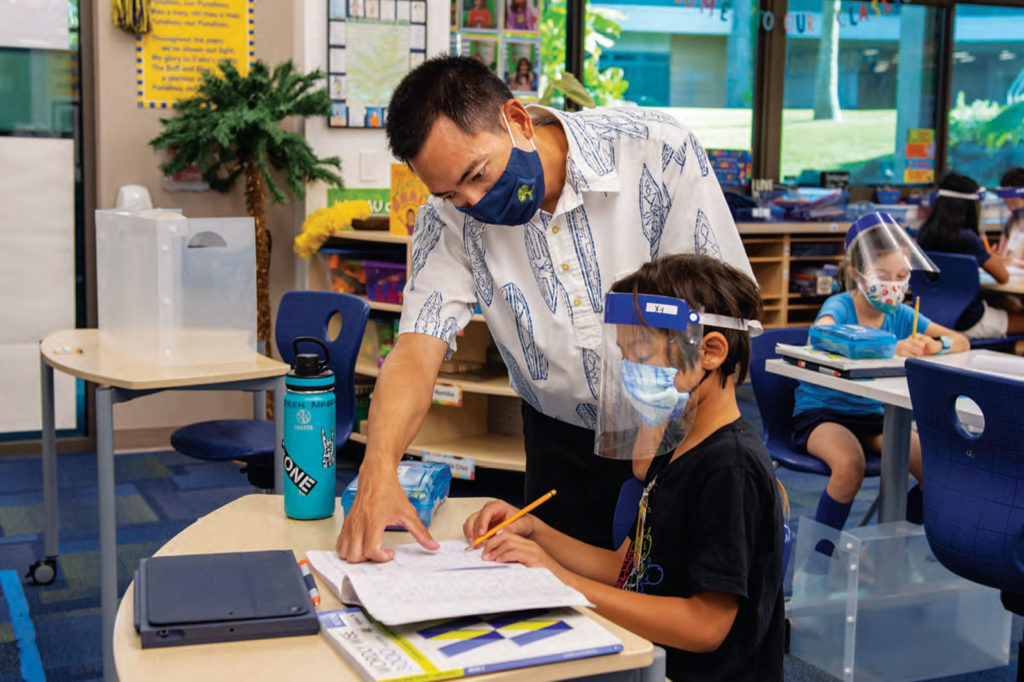

Jamie Dela Cruz is a veteran educator who now teaches third grade at Punahou.
I was just subbing at Punahou last year, even though I’ve actually been around the School for a long time in various roles. I’ve taught for 12 years in the DOE (Hawai‘i public schools), but I hadn’t been teaching full time for a couple of years. With of a lack of consistent work last spring, I had partnered with a company in the Silicon Valley to teach online advanced math and STEM classes, which really sparked a renewed love for teaching.
I signed up to be an assistant teacher this year, then all of a sudden, two weeks before school started, I became a lead teacher because they made the cohorts smaller. I was in a state of shock. I was prepared educationally and professionally, but not mentally. I was thinking I had a role, then it changed rapidly to something I wasn’t expecting.
It’s interesting how kids and their parents were anxious about coming back to school, but once they got here, they were saying, “Oh my gosh, don’t even say we might go back home. We are not going back home. This is so great.” When we asked them which they liked better, being at home or at school, a hundred percent said, “We love being in school.” Even with all the safety protocols in place, the kids understand the importance of it. They know that if someone gets sick, we all would need to stay at home. And they don’t want to be back at home, so they’re trying their best to stick by the rules.
A lot of people wonder how we’re doing as teachers. I would say it like this. If I were to be in a boat, I want to be in this boat. At Punahou, we are so fortunate to have the capacity to have such great facilities and staff to help keep us safe. We have enough PPE for everyone. I still do have concerns, like what happens if one of my students gets the virus. And I have to always keep in mind to be cautious when assisting my students. But sometimes, there’s no way I can show them math being far away. So I always have to find that balance between making sure I’m not too close so germs can spread, but to still walk over and help them to ensure that their learning is not compromised.
Overall, it’s been a really stressful time for teachers, with everything changing and all the protocols in place. You have to remember even small things like not letting the kids use someone else’s pencil, which is common practice in any other year. There are a lot of things on our plate. But Punahou is one of those places where people collaborate well. We communicate, and it’s like a family where everybody helps each other out. That’s really what has kept us more centered, with a feeling that we can all get through this.

Suhaila Ng ’22 is a junior at Punahou. During the earlier lockdowns, she began volunteering with Lyon Arboretum in Mānoa and Bishop Museum.
When they told us school wouldn’t be resuming after spring break, I understood it from a health perspective, but I was sad not being able to finish up my sophomore year on campus. For a couple of weeks, I was bummed out at home, not having direction. I didn’t know what to do with all the time.
During my freshman year, a Ph.D candidate from Duke University came to talk to my biology class about conservation botany and his work studying rare endangered native Hawaiian plants. That was really the impetus for my interest in conservation botany.
So in March, I started looking for opportunities to volunteer or intern in something related to conservation. I came across a posting for the Lyon Arboretum, which is near our house. They were looking for volunteers for their conservation seed lab, which is part of the Hawaiian rare plant program. I was thinking, “Plants, seeds. Awesome.” I applied, and they said, “Yeah, come in.”
During the summer, I went there nearly every day from 8 a.m. to 4:30 p.m. I also applied to volunteer at Bishop Museum in their botany department. I’m really interested in bryophytes, like mosses, liverworts and hornworts. I mentioned that, and they told me that they had a huge collection of native bryophytes that needed to be put into the database and filed. So that’s what I’ve been doing.
Having grown up in Hawai‘i, which is such a hotbed of biodiversity, I was passionate about nature from a young age.
Then when I got older, I learned about ecology and the detrimental impact humans have on the environment and endangered flora and fauna. I thought, “Humans are messing this up, so we should try to fix it in some way, shape or form.” I still have a lot of figuring out to do, but I’m definitely looking at schools for plant science and botany. I think that’s what I want to do with my life.
If the pandemic hadn’t happened, I wouldn’t have been able to get as involved as I have or learned as much. I needed an outlet, a way to get out of the house and put my energy toward something.
Obviously, I wouldn’t trade the millions of lives that have been lost in the pandemic to have these experiences. But if we’re looking at silver linings, getting involved with the conservation community was really one of the saving graces of the pandemic for me. I think this time has forced me and other teenagers to reflect inward and become more comfortable with who we are, because there are no distractions to pull us away from examining our character and the direction we’re going in life. It’s been a time for us to figure out who we are.

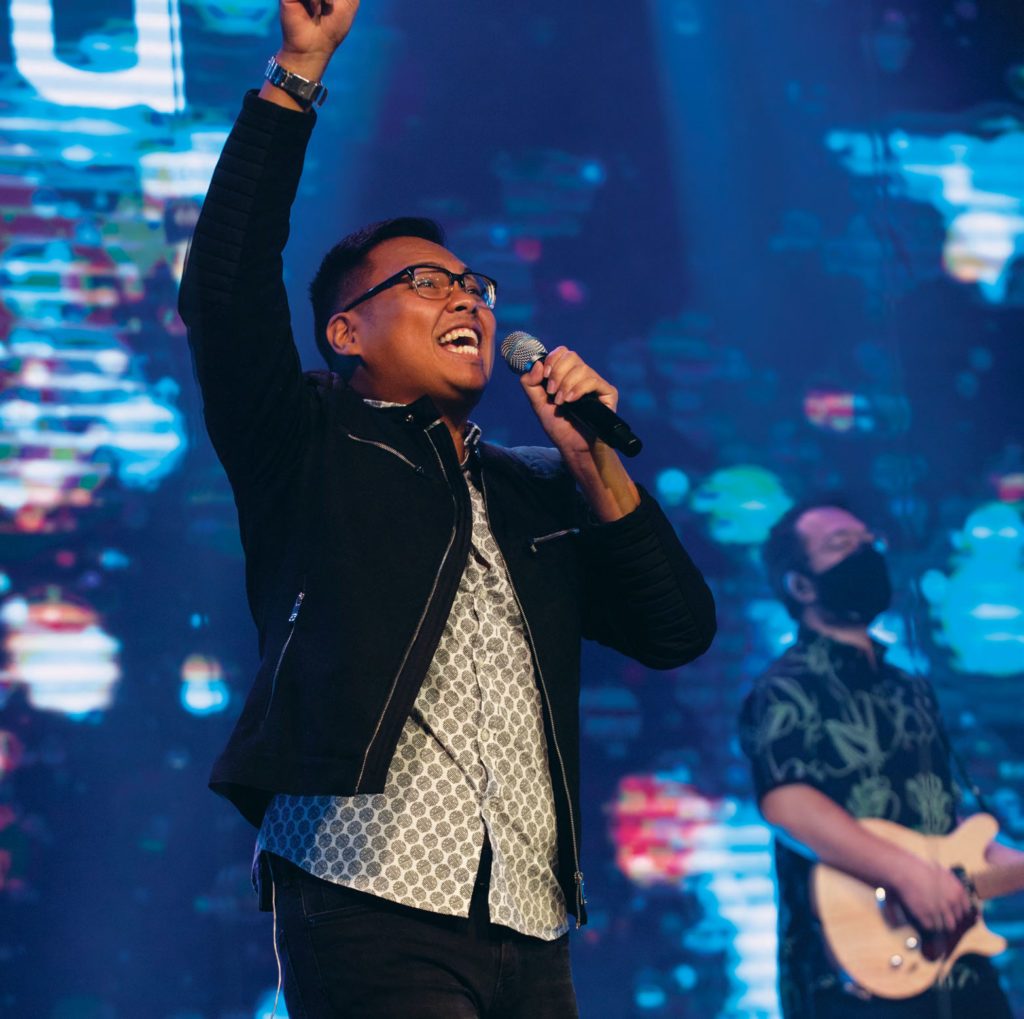

Yale graduate Donovan Sabog ’14 had a pandemic-induced epiphany last summer, to leave his corporate consultancy job in New York City and move home permanently. He is now Director of Administration at New Hope Oahu, training to be a pastor.
My job in New York was pretty much a textbook example of what a lot of people aspire to do after college. As a financial aid kid, I dreamed about making a lot of money, because my family wasn’t rich. And here I was at 23, living the dream. Then COVID hit. At first, the magnitude didn’t hit me. Then in March, everything came to a screeching halt. As a performer, it hit home when Broadway shut down. A few days later, I was back in Hawai‘i working remotely.
It was a time of despair and hope. I saw the tragedy and disaster, but I also saw the hope of humanity. You saw it in the thousands of essential workers. You saw it with people jumping to help wherever they were needed. There are times in life where you find yourself facing hills and valleys. When we have more strength, that’s our time to help others. I really wanted to be a helper. I was praying about it, saying, “God, would you allow me to make a difference?” He answered my prayers in such a huge way. I was lying in bed one night, and I just started crying, realizing that I had hope that could be shared with people through ministry.
In college, and even at Punahou, my friends and my family would say, “You say you’re going into business, but you’re going to end up being a pastor.” And I would say, “Absolutely not.” Being a Christian has always been a part of my identity, but I was apprehensive of becoming a pastor because of the stigma. People think you’re judging them and saying mumbo jumbo, and I thought I wasn’t good enough to be a pastor. Beyond that, you have to feel you were called to become a pastor, and I hadn’t felt that calling.
It took COVID to make me realize that even if my life helps just one person find hope, that’s what I want to do. That’s what happened that night. Yes, I could have become a millionaire by the time I’m 30 and have all the things that I dreamed of at one time, but none of that would be as fulfilling as helping someone get through a struggle. We can all think of that one person, or people in our lives, who’ve made a huge difference. I can think of so many people in my life who gave me hope when I didn’t have any.
I hadn’t told anybody what I was going through. But a couple of days after I had that realization, a friend called me randomly and said, “This sounds crazy, but God told me you need to be in ministry leadership.” Fast forward to that Saturday. I called one of my best friends from college, who was becoming a Catholic priest, to tell him the big news. But before I could tell him, he too confirmed that God was indeed calling me into ministry.
I told him specifically, “If John Tilton, the executive pastor of New Hope Oahu, offers me a job at the church, then I will know that’s what I’m supposed to do.” That night, I went to New Hope Oahu, which had just reopened for in-person services. I went just as a spectator, and the first person I see is John Tilton. He asks me, “Have you ever considered going into ministry? We’re looking for someone to be an administrator.” At that moment, I realized God had not just planted this dream in my heart for the future, but was saying, “I want you to do this now.”
I feel so blessed to be able to do this, especially at a time when people need hope and encouragement. I’ve never felt more peace or purpose in my life than I have right now.

Sia Liilii ’21 is a member of Punahou’s Varsity Girls Volleyball and Basketball teams
I’m appreciating life outside of sports more, so I’m actually thankful for this time. In the beginning, I was sad to not be able to play volleyball my final year before college. But now, I’m using the time as an opportunity to spend more time with my family. I’m one of 11 kids. I’m number nine, so one of the babies.
My dad’s a football coach, and I’ve been training with him since March. If COVID never happened, I wouldn’t have been able to do that. And usually during basketball season, I have basketball practice right after school. Then at night, I have club volleyball practice, so I was basically gone all day. I would see my family only late at night and on the weekends. My dad works a graveyard shift, so sometimes, I wouldn’t see him until the weekend. It’s been nice to spend time with him.
I am planning to play volleyball at the University of Nevada-Reno. Thankfully, the coaches looked at me during my junior year. Some of my friends got started later in the process, and they don’t have any offers, so they’re giving up the sport.
Quarantining was hard for me, to not see my friends for months. But I’m more appreciative of everything now. Before, I was thinking, “I’m going to play volleyball until the end of college.” Then COVID hit, and everything’s done. I’m thankful now just for the opportunity to play volleyball, and I’m definitely more thankful for my family. My mom’s a nurse, and her being on the front line has made me way more grateful for her and what she does.
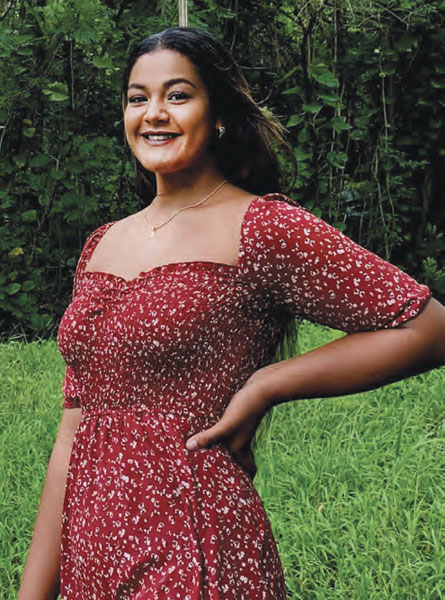

Virginia Loo ’92 is Punahou’s director of analytics and planning. She was hired in March 2020 to help Punahou with data-driven, strategic planning, but her job quickly morphed with the arrival of COVID-19. Since May, she’s been a key part of Punahou’s Pandemic Response Team, which spearheads current health and safety practices. Previously, Loo served as co-director for the Partnership for Epidemic Analysis and has worked for the Centers for Disease Control and Prevention (CDC), the Bill and Melinda Gates Foundation and as an epidemiologist for California’s Department of Public Health.
I got the job offer from Punahou the first weekend in March, before we shut down. At the time, I didn’t think COVID-19 would hit the U.S. hard. It’s funny, because when I was interviewing, I had to try really hard to explain how public health is relevant to an educational institution, and how I was going to use these skills. It did feel good to come into the job and say, “I know what we need to do,” and be able to translate recommendations from the CDC or World Health Organization into something meaningful for our setting.
I was supposed to start the first week of July, but the School was putting the Pandemic Response Team together, and Mike (Latham) thought it would be good for me to join them in May, so I did. Since then, about 95% of what I do is pandemic work. Even though this wasn’t what I was hired to do, it does involve strategic planning and data. And what’s great is that I met people in all the different departments and quickly learned a lot about the School.
We have weekly Pandemic Response Team meetings, and it’s a bit like the military. Each group reports on where they are and what they’re doing. In early summer, the cases were low, and we were preparing to return to campus in a green tier. We got nervous when cases started rising, and we thought we would have to open in yellow. Then, it moved to red, and things got really difficult. It went so fast, and we had to make all these shifts.
We’ve had so many details to work out to open the campus. For a while, it was really intense. We were working late into the night, the early hours of the morning and weekends. Even though we started the school year in distance learning, we were still looking forward to returning to campus. Right before that happened, we ran dress rehearsals for the faculty, almost two weeks before we brought students back. It helped a lot, so by the time students arrived, it was almost a relief.
Overall, there was been a lot of good will in the whole effort. People were excited to come back to campus, and when we saw everyone, we realized this is why we’re doing this. This is what makes it worthwhile.
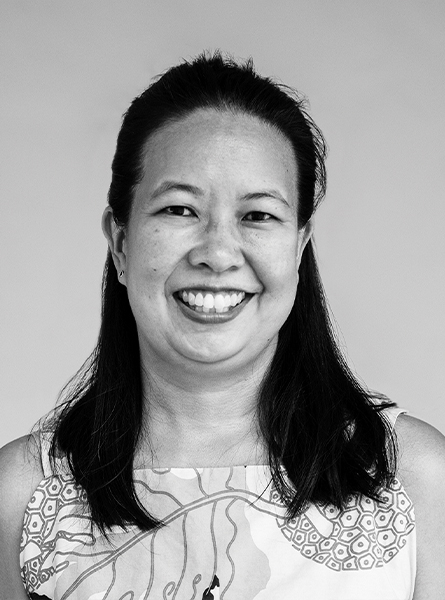

Throughout the pandemic, Olivia Doi ’94 Fleming has been working remotely for her corporate banking job at American Savings Bank. She and her husband Jason Fleming ’94, medical director of emergency services at Kuakini Medical Center, have two sons, Everett, 5, and Jonah, 14.
Life and parenting have been super challenging while working full time from home. My mom has stage 4 cancer and got COVID. Fortunately, she didn’t have symptoms from the COVID, but she’s still really sick. My dad is sick too, and Jason’s dad passed away during the pandemic. At first, we weren’t even sure with the new pandemic rules if it was safe for us to visit them. What if we unknowingly infected them with COVID, and they got even sicker? It was confusing, sad and isolating for everyone. It’s been tough to juggle taking care of parents and kids, and be available for everyone. I love my kids. I love my mom, and I love my company, but sometimes, it’s just tough.
I’m in a better place these days. I started working out again, and I feel so much better. We got a Peloton in the middle of the pandemic, and I run or bike every day. I’ve been able to work out consistently for maybe two months now. It’s helped me find balance. I also have a garden, so I have fresh vegetables in the backyard – bok choy, kale, chives, green onions and lettuce. I never gardened before, and I thought it would be complete disaster, but it’s actually really fun.
I haven’t had much time for myself since I had Everett. I was so busy working and feeling guilty that I wasn’t working hard enough, so I ended up staying late and working even more. I grew up with a very strong work ethic. When my father was a young man, he helped support his family by working on the plantation. His father died in a plantation accident when my dad was 11, and his mother passed away of a stroke two years later. He and his brothers and sisters all chipped in to earn money, so they could stay together. The work ethic was just ingrained in me. We were taught that with work, you give it everything.
I’ve learned though to think about our family first, and sometimes, say “no” to other things so we can do things together. We’re exercising more as a family. We go to the pool. We go in the backyard and play games. We’re trying to have more good moments and let go of the work. I have a different perspective now of what’s important, especially with my older son. Before, we focused on school. We’d say, “You’re not doing your schoolwork. You’re not doing this or that.” We’ve learned to let that go, and let go of all the things that aren’t as important, so we can focus on being closer as a family.



Michelle Arnold is Punahou’s Director of Athletic Performance. Since last March, she and others in the School’s Athletics Department have been tasked to help the School in a variety of roles.
Last March, after the lockdown, we didn’t have answers for our student-athletes. There was a huge question mark, especially for our seniors. The seasons were canceled, but we had to figure out what we would do going forward. We had different virtual training programs over the summer in the event we could open up in August. But while our athletes were optimistic, it was a struggle to keep up their engagement as the summer wore on. We all could see the writing on the wall that there wouldn’t be a fall season. The unknown has been the most frustrating part. We’re still at the mercy of the coronavirus cases. But even though we’ve had curve balls thrown at us, that’s okay. We’ll figure it out together. That’s the message we’re sending to our coaches and kids.
I’m very appreciative the School has made it a priority to keep us all here. In Athletics, we’re all appreciative of that. We have responsibilities all over campus, and we’re all willing to go wherever we’re needed. We’re safety monitors. We have lunch duty. We helped with the drive-through distribution events. We’re always there to jump in. It’s teamwork, and that’s how our department works. If anybody needs a hand, we’re going to do whatever we can to help. It’s actually been fun. Right now, I get to intersect with PE even more than before. I’m teaching a strength training class, and it’s awesome working with students who maybe I normally wouldn’t interact with.
We want to engage more, not just with our student-athletes, but our overall student body. We’ve been sitting and crouched over desks and staring at computers for months now, so we started this Get Moving, Stay Active campaign. We have a group of students who join us at 4 p.m. on Monday, Wednesday and Friday to work out together from home. It’s fun to see how creative kids get when they try to add resistance or weight to their workouts. I’ve seen kids squat, carrying their dogs, rice bags, you name it. So that’s cool.
Our biggest challenge right now is getting our student-athletes ready for sports that are starting in January. We have this short window to prepare. We want to do whatever is possible to get them ready, even though things are still up in the air.

Shanon Makekau is a pulmonologist at Kaiser Permanente’s Moanalua Medical Center and mom to Rynn ’30, Maila ’32 and 4-year-old Kai.
My first COVID patient was in pulmonary distress when I met him. He was in the ICU, on a ventilator and truly fighting for his life. He was not the picture of what we were anticipating severe COVID cases to look like. He was a young man who was otherwise fairly healthy. As someone who is in the same general ballpark, it was a very sobering thing. Looking at my own mortality, as a parent especially, you’re looking into the window of what this disease can do. It was really my first feeling of true fear.
A recurring theme for me as a physician, who is also a mother, is that every patient that I interact with who has this disease comes with their own story. They have a family. Oftentimes, they have children. They have a job, friends and co-workers. It’s given COVID a very human face. And it makes me, as a mom, reflect upon my own story. If I get infected as a byproduct of my job, how would that impact my loved ones?
It’s really changed how I interact with my family when I get home. Before, as soon as they heard my car in the garage, the front door would fly open and my kids would be waiting to greet me. And there would be lots of hugs. Before I could even put my things down, they would be talking about the day, and there was just a lot of excitement. I certainly looked forward to that moment. Now, there’s a little bit of necessary separation. I come through the back door, change and throw my work clothes in the washing machine and take a shower right away. Thankfully, my kids are still young enough that they’re excited to see me. A part of me mourns for the spontaneity that’s lost and that free expression of joy at being reunited.
The thing that really gave me pause was the first shutdown – when life as we knew it ceased to exist and everybody was sheltering anxiously at home. Yet, I had to go to work. The instinct as a mom was to stay with my family, keep them safe, provide reassurance. But I had to pull myself together, and say, “No, my responsibility is to work right now, and the need is far greater there.” I remember that day. My kids couldn’t understand why Mommy had to go to work. That day was probably one of the hardest.
The enduring change in how I live life is that whether I’m at work or at home, I truly reflect on how I want to use that time, how I want to experience the day. The irony is that we don’t have a lot of options. But I feel like maybe because of that mindfulness, life is richer and more intentional, and maybe even more fulfilling.
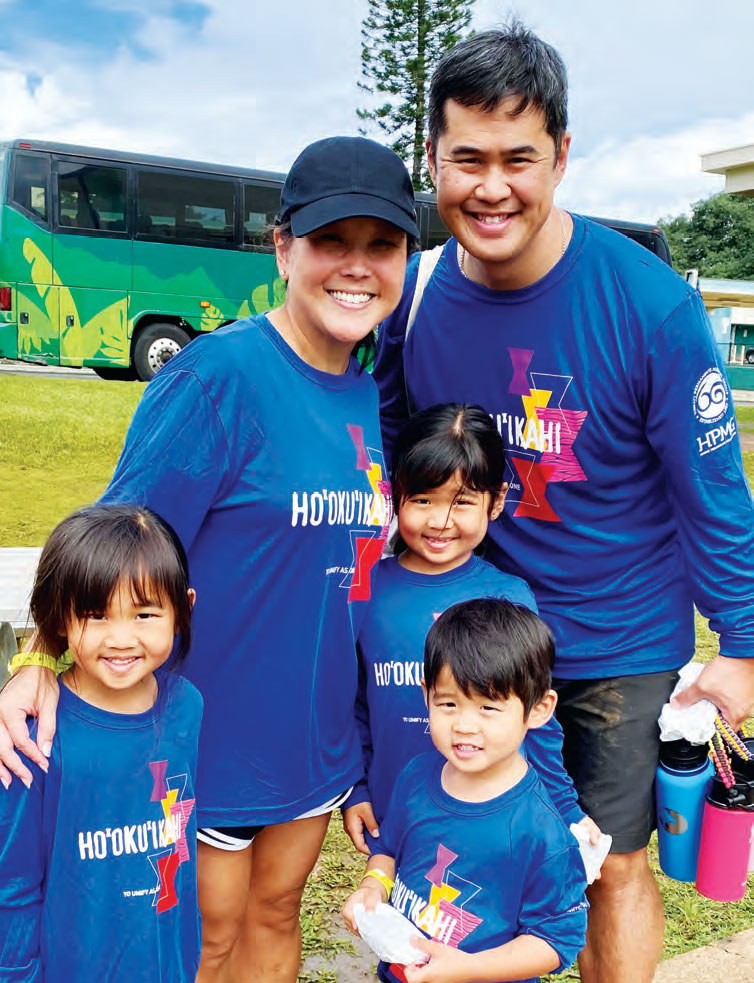

Anjoli Roy teaches English in the Academy. She is the author of the chapbook, “Enter the Navel: For the Love of Creative Nonfiction.”
It was definitely challenging last spring when the school made an emergency shift to distance learning. But I’m really grateful for my colleagues, particularly the ones in the English department with experience teaching online, because they started sharing skills, techniques and ideas. I was also glad we had the summer to learn some other online platforms, which we used when the fall semester started in the red tier. Distance learning was so much easier because of that, and also because the schedule was different with block and semester courses.
I think I had the same reservations coming back to the classroom that a lot of us had. I was worried about getting sick and also about passing it on to others. To be honest, these are worries I still have. There’s so much guilt associated with this pandemic, as well as blame. I haven’t necessarily seen that happening on campus, but it certainly is happening in the larger world. In returning to campus, I wanted to make sure I could keep kids safe in the classroom, abiding by the social distancing rules, but still being as comfortable as possible.
School definitely doesn’t feel the way it normally does when kids can move around casually in class and meet up with their friends on campus. The energy I’m used to feeling in the classroom is definitely not the same either. But, our current social-distancing rules are necessary and important, and students are really resilient. They show us that every day.
I would be lying if I said everything is great. I mean, it’s hard for all of us to be living through this time, and teaching in this format presents its own variety of challenges, but I’m grateful to have this job, and I’m grateful to work at an institution that takes contact tracing seriously. We’re all doing our best. I think about my colleagues teaching in other cities but having very different experiences because they’ve been unable to open safely, or my friends who work in public schools who don’t have proper PPE.
All of this said, I still wouldn’t trade teaching for anything. Honestly, I love it. It’s difficult and demanding, and not every day is a success story, but when you see a kid who’s been struggling turn a corner, and maybe you were part of the reason for that, it’s such a huge gift.


Tate Goodman ’22 is the Junior Class vice president and co-chair of this year’s Carnival.
Right before spring break, I started seeing stories in the news about COVID. At first, I thought it was fake news, so I ignored it. But then after spring break, we didn’t return to school. I thought it would only be for a couple of weeks, but it’s turned into this year-long thing.
Even though COVID is unfortunate, it’s opened up new experiences for me. Instead of taking glassblowing for my elective, I’m in a Global Online Academy engineering course with kids from all over the world. It’s been super interesting. We’re working on projects together, and it’s cool to talk to other people from other countries who aren’t that different than me. I was speaking to this girl from Thailand the other day. She seemed like just a regular girl from Hawai‘i. We have a lot in common.
It was strange at first to come back to campus and go to school in person, with everyone wearing masks and being socially distanced. I’m getting used to it, though, and I think it’s good that people are starting to make new friends within their cohorts. For me, personally, the hardest part of the pandemic has been quarantining at home and not hanging out with my friends as often as I normally would. This year in school, we also may not be able to have our traditional events, such as Junior Function. If we are able to do something – great. But I think in the back of our minds, we all understand that we aren’t going to be able to do everything this year as was done in the past.
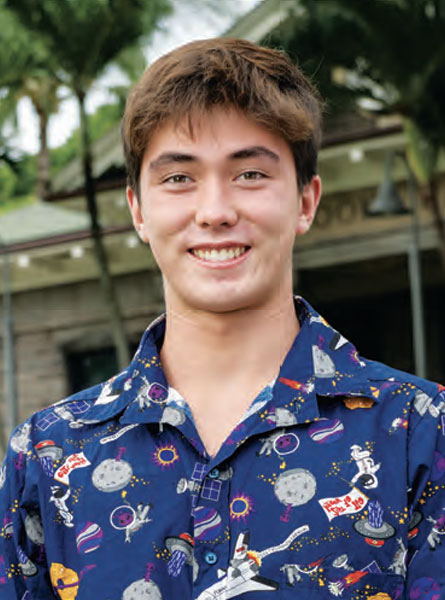


When this interview was conducted, Emily Hawkins ’11 worked as a call center representative for New York City Health and Hospitals. She now works at NYU Langone Fertility Center.
Before the pandemic, I was producing independent theatre in New York. I had just finished production on a play the week prior to the city’s shutdown. I also ran the events program at a Brooklyn bar. Immediately, things in New York got surreal. We all went into crisis mode, and everything stopped. Luckily, a friend sent me a job posting about the city looking to hire people to work at COVID-19 testing sites. I started working the following week at a drive-through testing site in Staten Island. I did intake, yelling at people through their car windows and asking for personal information so we could fill out paperwork to get them tested. In the beginning, we saw hundreds and hundreds of people a day. It was apocalyptic and stressful.
Every week, I thought about quitting, because it just felt dangerous. But I stayed on, because I felt I had a purpose. But then as the numbers dropped, the risk outweighed the rewards. The logistical challenges of working in Staten Island also became a bigger burden than it was worth, so I left that job in June. In July, I got a job working remotely, which was easier and safer. I’m working for New York City Health and Hospitals as a call center representative. I call people with their COVID-19 diagnosis and antibody test results, letting people know if they are positive or negative.
I don’t totally know what’s keeping me in New York. My parents ask me the same thing. They both lived here for many years, so I think they get it on an emotional level. To me, it feels like I have a community. I have a partner who lives here and wants to stay here, and New York feels like home. I feel strongly about finding ways to serve this city, and I was lucky to have the opportunity to do that through these COVID-era temp jobs.
My dad said to me, “You should think about grad school. You could use this time to figure out what you want to do career wise for the next 30 years.” I think it was well-intentioned, but I can’t wrap my mind around 30 years, 10 years or even five minutes. I would say, though, I’m open to different career paths more than before. Ultimately, I’ll find my way back to something creative. I feel like I’ll figure it out.
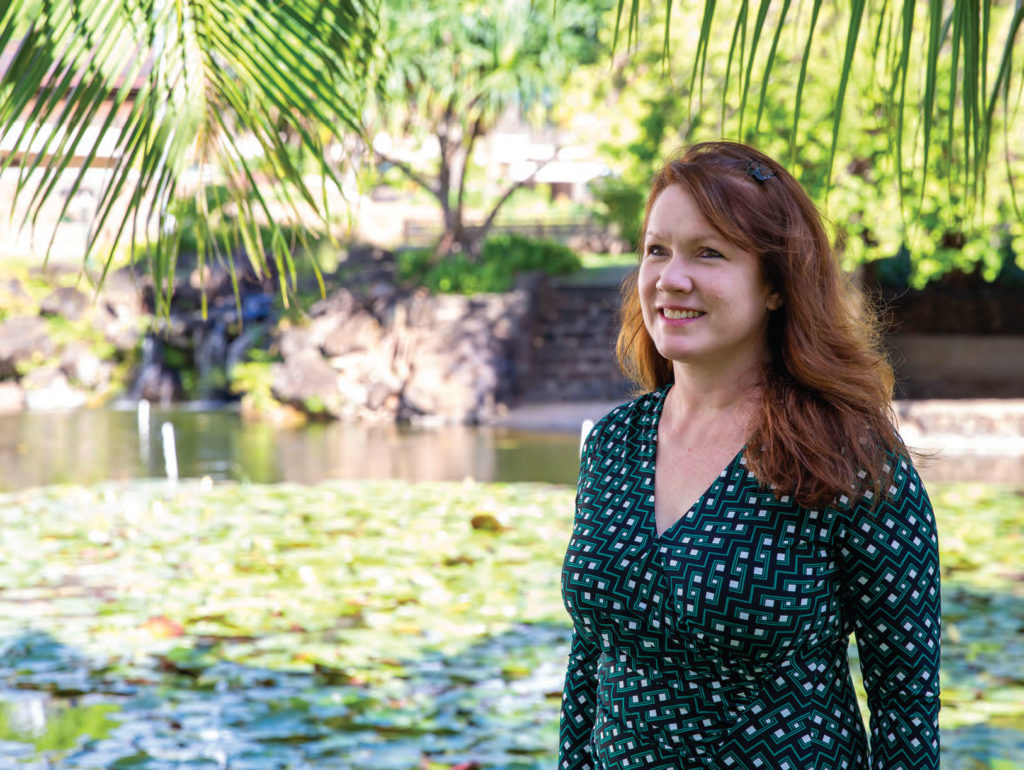

Nicole Chong Kee ’96 McDonald is a support specialist with Punahou’s IT Help Desk. Her two children, McKenzie ’23 and Kellen ’30, attend Punahou.
Since COVID, we’ve been working all kinds of hours – in the evenings and weekends. Our workload has been intense, because along with our normal tech work, we support Webex, the cameras and all the other devices and technology being used.
Since the start of the pandemic, it’s been all hands on deck in our department. Our staff had to be trained to offer remote support, because we weren’t used to using remote tools. But after COVID, we had to do everything remotely and help teachers with Webex 24/7, which caused a lot of anxiety for everybody. We also had to plan for students to return to school, making sure classrooms were equipped with cameras and things like that, which took time, because right after the lockdown, you couldn’t get a webcam anywhere because of the demand.
Overall, things have been stressful, but also a good experience. I’ve learned a lot of new things, like how to make tutorial videos. I’m still not totally comfortable talking on video, but I had to make these videos about how to do various things, so I’ve gotten used to it. And even after COVID, people could still work remotely, because we have all the tools implemented, and teachers are used to teaching students who may be at home. So even though it’s been a lot of work, I’m thinking a lot of things we’re doing is planning for the future.





































